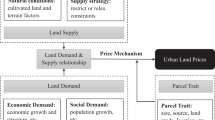Abstract
Coase’ famous paper on durability and monopoly starts with an example of a land monopolist, who turns out to be difficult to find in the real world. The Chinese constitution stipulates that all urban land is owned by the government, thus making Chinese cities a natural experiment for the Coase Conjecture on land monopoly. This paper uses land-leasing data in 290 prefecture-level cities in China to test the existence of strategic behaviors in local governments as land monopolists. The estimation shows with both a simple linear regression model and a random trend model that, after controlling for city size, urban growth and income, land prices decline over time. We also found that the results for land price through negotiation and that through tender, auction and listing (TAL) are very different. This suggests that the local government’s monopoly power in the market of industrial land, which are mostly sold through negotiation, is much weaker than in the market of residential and commercial land, which are mostly sold through TAL. In conclusion, this paper supports the argument that urban land is a special type of durable goods and urban land monopolists act strategically.
Similar content being viewed by others
Notes
Henceforth, the two models are called the population model and GDP model, respectively.
Researchers on many other countries often use metropolitan area population based on commuting flows or time distances. Unfortunately, that statistic is not available in China.
County is a lower level administrative unit than prefecture. A prefecture-level city may consist of multiple counties. A county includes many rural areas, while its center (or urban area) is located in a town under its administration.
References
Ahn S, Arnott R (2021) Market power and urban housing development. Environ Plan B. https://doi.org/10.1177/23998083211037687
Arnott R (1989) Housing vacancies, thin markets, and idiosyncratic tastes. J Real Estate Financ Econ 2(5):5–30
Basu K, Emerson PM (2003) Efficiency pricing, tenancy rent control and monopolistic landlords. Economica 70:223–232
Bulow JI (1982) Durable-goods monopolists. J Polit Econ 90(2):314–332
Cai H, Wang Z et al (2015) To build above the limit? implementation of land use regulation in urban China. J Urban Econ 98:223–233
Cai H, Henderson JV et al (2009) China’s land market auctions: evidence of corruption. NBER Working Paper (15067)
Coase RH (1972) Monopoly and durability. J Law Econ 15:143–149
Deng FF (2005) Public land leasing and the changing roles of local government in urban China. Ann Reg Sci 39(2):353–373
Deng F (2009) Comparative urban institutions and intertemporal externality: a revisit of the coase conjecture. J Inst Econ 5(2):225–250
DiPasquale D, Wheaton WC (1996) Urban economics and real estate markets. Prentice Hall Inc, Englewood Cliffs
Du J, Peiser RB (2014) Land supply, pricing and local governments’ land hoarding in China. Reg Sci Urban Econ 48:180–189
Evans AW (1991) On monopoly rent. Land Econ 67(1):1–14
Fang L, Tian C et al (2018) Political cycles and the mix of industrial and residential land leasing. Sustainability 2018(10):1–24
Fang H, Gu Q et al (2015) Demystifying the Chinese housing boom. NBER Working Paper (21112).
Fischel WA (1985) The economics of zoning laws: a property rights approach to American land use controls. The John Hopkins University Press, Baltimore
Foldvary FE (1993) On monopoly rent: comment. Land Econ 69(1):108–110
Fudenberg D, Tirole J (1998) Upgrades, tradeins, and buybacks. RAND J Econ 29(2):235–258
Groseclose T (2021) One-sided bargaining over a finite set of alternatives. J Public Econ Theory 23:933–957
Huang Z, Du X (2017) Government intervention and land misallocation: evidence from China. Cities 60:323–332
Laussel D, Van Long N (2021) Quality differentiation in durable goods monopoly always yields strictly positive profits. Cesifo Working Paper 9331. Center for Economic Studies and ifo Institute (CESifo), Munich, pp 1–7
Lizieri C, Garza N (2018) An empirical approach to urban land monopoly: a case study of the city of Barranquilla, Colomibia. Urban Stud. https://doi.org/10.1177/0042098018781306
Peng L, Thibodeau TG (2012) Government interference and the efficiency of the land market in China. J Real Estate Financ Econ 45:919–938
Stokey NL (1981) Rational expectations and durable goods pricing. Bell J Econ 12(1):112–128
Tao R, Su F et al (2010) Land leasing and local public finance in china’s regional development: evidence from prefecture-level cities. Urban Stud 47(10):2217–2236
Tian L, Ma W (2009) Government intervention in city development of china: a tool of land supply. Land Use Policy 26:599–609
Wang Y, Hui EC-M (2017) are local governments maximizing land revenue? evidence from China. China Econ Rev 43:196–215
Wu Y, Zhang X et al (2014) Industrial land price and its impact on urban growth: a Chinese case study. Land Use Policy 36:199–209
Wu Q, Li Y et al (2015) The incentives of China’s urban land finance. Land Use Policy 42:432–442
Yang Z, Ren R et al (2015) Land leasing and local government behavior in China: evidence from Beijing. Urban Stud 52(5):841–856
Acknowledgements
I thank Lanlan Wang for her generous help in data collection.
Author information
Authors and Affiliations
Corresponding author
Additional information
Publisher's Note
Springer Nature remains neutral with regard to jurisdictional claims in published maps and institutional affiliations.
About this article
Cite this article
Deng, F. Local governments as land monopolists in Chinese cities: a natural experiment of Coase Conjecture in urban land. Asia-Pac J Reg Sci 6, 159–189 (2022). https://doi.org/10.1007/s41685-021-00223-6
Received:
Accepted:
Published:
Issue Date:
DOI: https://doi.org/10.1007/s41685-021-00223-6




